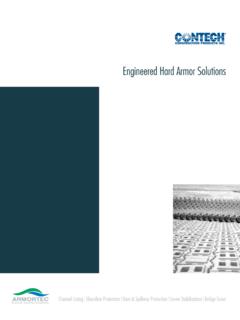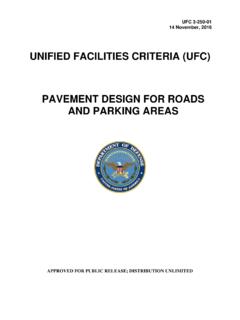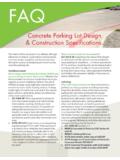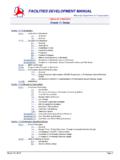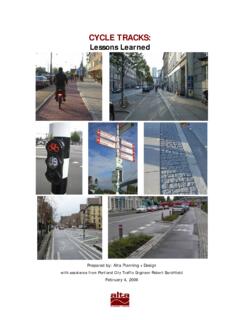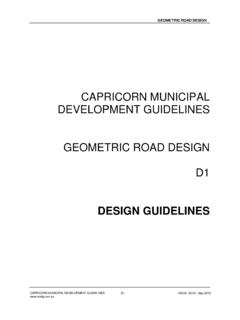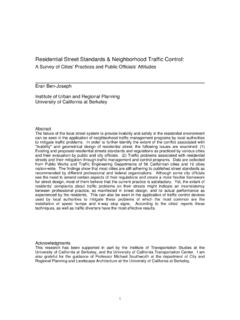Transcription of TECH SPEC - Panablock
1 1995 ICPI tech spec No. 4 Interlocking Concrete pavement Institute Revised February 2003 Figure 1. The Roman Appian Way: earlyinterlocking design of Interlocking Concrete pavement forRoads and Parking LotsHistoryThe concept of interlocking concrete pavementdates back to the roads of the Roman were constructed with tightly fitted paving unitsset on a compacted aggre-gate base. The modern ver-sion, concrete pavers, ismanufactured with close tol-erances to help ensure inter-lock. Concrete pavers weredeveloped in the Nether-lands in the late 1940 s as areplacement for clay brick streets. A strong, millen-nia-old tradition of segmental paving in Europe en-abled interlocking concrete pavement to spreadquickly.
2 It is now established as a conventional meansof paving there, with some two billion ft2 (200 mil-lion m2) installed annually. Concrete pavers came toNorth America in the 1970 s. They have been usedsuccessfully in numerous residential, commercial,municipal, port and airport paving system offers the advantages of con-crete materials and flexible asphalt high-strength concrete, the units have high resis-tance to freeze-thaw cycles and deicing salts, highabrasion and skid resistance, no damage from petro-leum products nor from concentrated point loads orhigh temperatures. Once installed, there is no wait-ing time for curing. The pavement is immediatelyready for traffic. Stress cracking and degradation ofthe surface is minimized because the numerous joints,or intentional cracks, act as the means for loadtransfer.
3 Like flexible asphalt pavement , an aggre-gate base accomodates minor settlement without sur-face cracking. An aggregate base facilitates fast con-struction, as well as access to underground installation of concrete pavers can fur-ther shorten construction time. pavement reinstatementis enhanced by reusable paving units, thereby reducingwaste Principle of InterlockInterlock is critical to the structural performanceof interlocking concrete pavement . When consid-ering design and construction, three types of inter-lock must be achieved: vertical, rotational, and hori-zontal interlock. These are illustrated in Figure 2. Ver-tical interlock is achieved by the shear transfer ofloads to surrounding units through sand in the interlock is maintained by the pavers be-ing of sufficient thickness, placed closely together,and restrained by a curb from lateral forces of ve-hicle tires.
4 Rotational interlock can be further en-hanced if there is a slight crown to the pavement crosssection. Besides facilitating drainage, the crown en-ables the units to tighten slightly through loads andminor settlement across the entire pavement , therebyincreasing structural interlock is primarily achieved throughthe use of laying patterns that disperse forces frombraking, turning, and accelerating vehicles. The mosteffective laying patterns for maintaining interlockWhen considering design and construction,three types of interlock must be achieved:vertical, rotational and horizontal interlock. tech spec tech SPECNUMBER 42 Figure 3. Layingpatterns forvehicular herringbone patterns. Testing has shown thatthese patterns offer greater structural capacity andresistance to lateral movement than other layingpatterns (1, 2, 3).
5 Therefore, herringbone patterns arerecommended in areas subject to vehicular Figure 3. Stable edge restraints such as curbs areessential. They maintain horizontal interlock whilethe units are subject to repeated lateral loads fromvehicle tires. ICPI tech spec 3, Edge Restraints forInterlocking Concrete Pavements offers guidance onthe selection and detailing of edge restraints for arange of pavement Designand ConstructionFigure 4 illustrates typical schematic cross sec-tions for interlocking concrete pavement . Boththe base and subbase are compacted aggregate. Manypavements for city and residential uses do not re-quire an aggregate subbase except for very heavyuse, or over a weak soil subgrade.
6 In these situa-tions it may be more economical to use asphalt orcement stabilized base layers. They are often placedover a subbase layer of unbound compacted is covered in ICPI tech spec 2,Construction of Interlocking Concrete steps for preparing the soil subgrade and basematerials are similar to those required for flexibleasphalt pavements. After the base surface is built tospecified elevations and surface tolerances, beddingsand is screeded in an even layer, typically 1 11/2 in.(25 40 mm) thick. The units are placed, manually ormechanically, on the smooth bedding sand, con-strained by stationary edge pavers are vibrated with a high frequencyplate vibrator. This action forces sand into the bot-tom of the joints of the pavers and begins compactionFigure 2.
7 Types of interlock: vertical, rotational, , subgrade soil strength, and pavementmaterials. The design engineer selects valuesrepresenting attributes of these factors. Thevalues can be very approximate correlationsand qualitative assumptions. Each factor, how-ever, can be measured accurately with detailedengineering studies and extensive laboratorytesting. As more detailed information is ob-tained about each factor, the reliability of thedesign will effort and cost in obtaining informa-tion about each should be consistent with theimportance of the pavement . A major thor-oughfare should receive more analysis of thesoil subgrade and traffic mix than a residentialstreet. Furthermore, the degree of analysisand engineering should increase as thesubgrade strength decreases and as the antici-pated traffic level increases.
8 In other words,pavements for high volume traffic over weaksoils should have the highest degree of analy-sis of each factor as is Moisture and temperaturesignificantly affect pavement . As moisture inthe soil or base increases, the load bearingcapacity of the soil or the strength of the basedecreases. Moisture causes differential heav-ing and swelling of certain soils, as can affect the load bearing ca-pacity of pavements, particularly asphalt sta-bilized layers. The combined effect of freezing tem-peratures and moisture can lead to the two detrimen-tal effects. First, expansion of the water during freez-ing can cause the pavement to heave. Second, thestrength of the pavement materials can be reduced detrimental effects can be reduced or elim-inated one of three ways.
9 Moisture can be kept fromentering the pavement base and soil. Moisture can beremoved before it has a chance to weaken the pave-ment. pavement materials can be used to resist mois-ture and movement from swelling or frost. Limitedconstruction budgets often do not allow completeprotection against the effects of moisture and freeze-thaw. Consequently, their effects should be mitigatedto the highest extent allowed by the available budgetand this design procedure, the effects of moistureand frost are part of characterizing of the strength ofsubgrade soil and pavement materials. Subjectivedescriptions of drainage quality and moisture condi-tions influence design strength values for sub-grade soils and unbound granular materials.
10 Inaddition, if freeze-thaw exists, then soil subgradestrength is reduced according to the degree of itsfrost When pavement is trafficked, it receiveswear or damage. The amount of damage depends onthe weight of the vehicles and the number of expectedpasses over a given period of time. The period of time,of the bedding sand. Sand is then spread and sweptinto the joints, and the pavers are compacted againuntil the joints are filled. Complete compaction ofthe sand and slight settlement of the pavers tightensthem. During compaction, the pavement is trans-formed from a loose collection of pavers to aninterlocking system capable of spreading verticalloads horizontally. This occurs through shear forcesin the design ProcedureThe load distribution and failure modes offlexible asphalt and interlocking concrete pave-ment are very similar: permanent deformation fromrepetitive loads.
